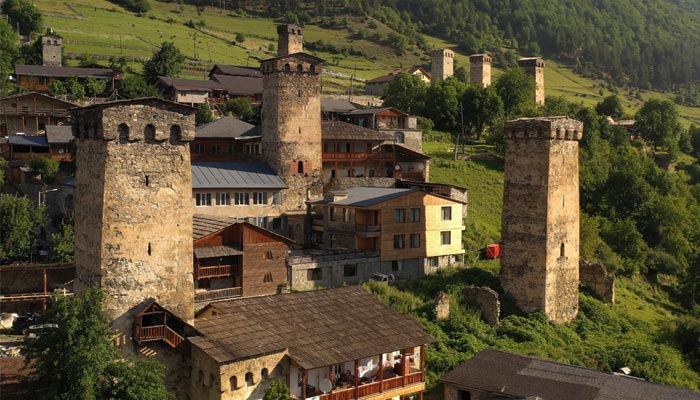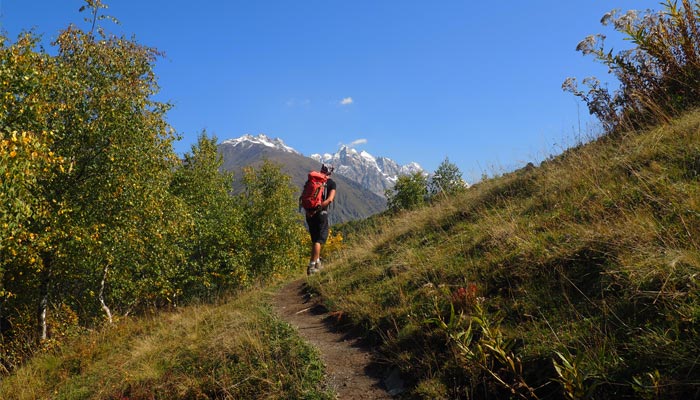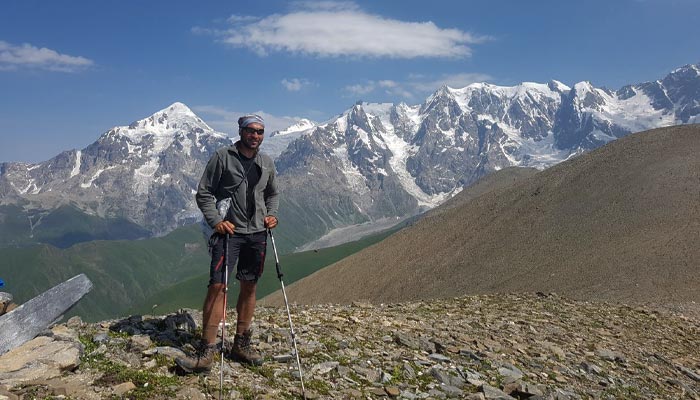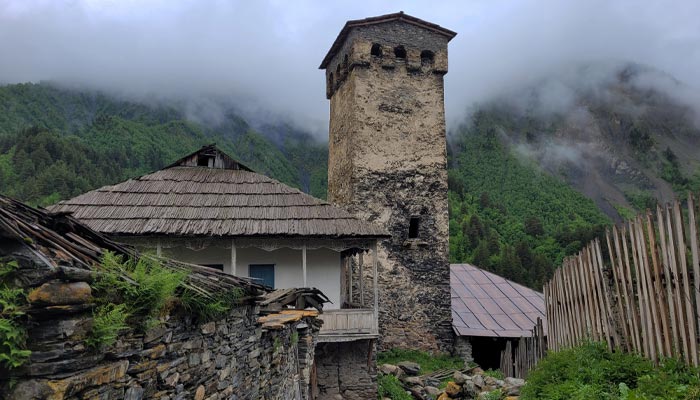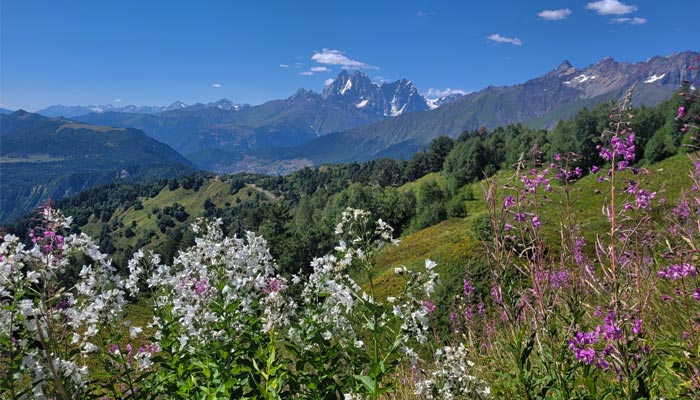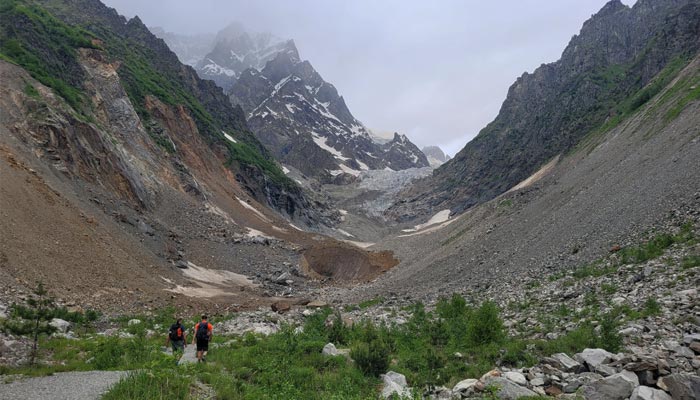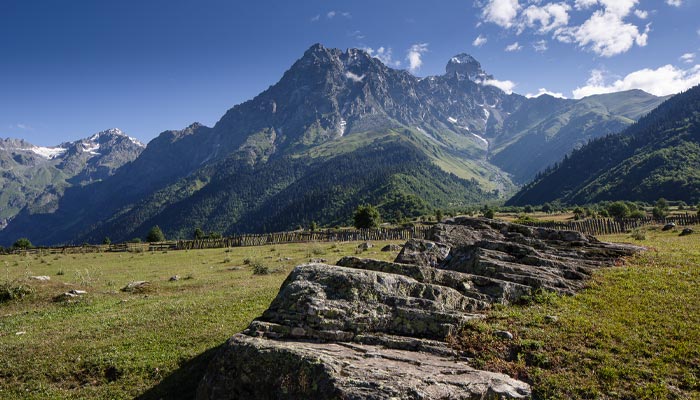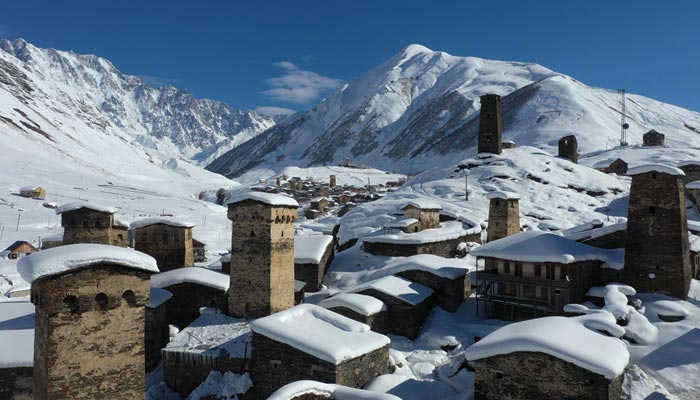|
Svaneti Svaneti is well known to many people in and outside the Caucasus, even those who have never been to Georgia, for its magnificent scenery and impressive fortified towers. Whether you are interested in nature, culture or gastronomy, Svaneti is a special part of the world in every respect. The fact that this relatively small region has its own language also speaks to the uniqueness of Svaneti and its people. Svaneti is a historical-geographical region in the northwestern part of Georgia, and due to its difficult terrain and inaccessibility for several centuries, it is historically considered a culturally closed space with a special history and architecture, as well as its own language and other specific social and economic conditions. General info Area: 5 776,4 km² Svaneti from Sky Here You can visit our YouTube channel and enjoy 4K footage of Svaneti Two Svaneti Svaneti consists of two parts, Upper and Lower Svaneti. The upper part includes the villages of the Enguri Valley: Etseri, Mestia, Kala, Ushguli and the Lower Svaneti includes the villages in the Zcheniszqali valley: Mele, Mami, Lentechi, etc. Cultural and natural highlights There are few regions in the world that can offer so many scenic and cultural highlights in such a small area as Svaneti. Svaneti is called an "open-air museum" and it would take at least five pages to list everything, but here is at least a small list of the most popular natural and cultural monuments of the region. Scenic highlights: 1. Mount Tetnuldi 4,858 m. Cultural monuments: 1. UNESCO World Heritage Site of Ushguli and its fortified towers. Museums 1. Ethnographic and Historical Museum of Mestia Ski resorts 1. Hatsvali, above Mestia Hiking routes In Svaneti there are numerous hiking routes of all levels of difficulty. The beauty of hiking in Svaneti is that you don't have to stay in a tent. If you plan your route well, you can stay in a local guesthouse, where you will have hot showers, good food and friendly hosts. For campers, there are many places in the Swan Mountains where you can camp safely and free of charge. Here is a small selection of popular hiking routes in Svaneti 1. Three-to-four-day trek from Mestia to Ushguli Traditions in Svaneti In no other region of Georgia are medieval and partly pre-Christian traditions as well preserved as in Svaneti. Nowhere else can the mixture of Christian high culture and archaic traditions be felt so clearly in the customs and various rituals as in Svaneti. Lamproba Lamproba is a very important folk festival in Svaneti, which used to be celebrated in other parts of Georgia as well, but in its original form it has been preserved only in Svaneti. During the festival, each family prepares a large bonfire from birch or oak branches and lights it during the night. The whole family gathers around the fire and celebrates in the form of an archaic Christian liturgy, with toasts, festive food, prayers, songs and dances. Lamproba is celebrated three times a year, and because it is linked to the lunar calendar, the date usually varies, but it is celebrated in February or March and always at night. As mentioned above, Lamproba is celebrated three times a year and also serves three different purposes: 1. at the first Lamproba, prayers are made to the Lord (originally the gods) for a good harvest, so the first Lamproba is for a good harvest. The fire is lit by each family in the field, a table is set with a rich feast and celebrated in the form of a liturgy with prayers and songs. The second Lamproba is a kind of prayer for the souls of the deceased and is used to warm the souls of the deceased in the underworld and to light their way to the other world. The fire is lit directly in the cemetery, the family of the deceased gathers around the fire and various toasts are offered in the form of prayers. The third Lamproba is used to count the adult male members of the family in the villages and to find out how many fighters the village can provide in case of need. In this case, as many fires are lit in front of the house as there are adult male members of the family. Lipanali Lipanali is a very important tradition in Svaneti, celebrated by every family, especially in Upper Svaneti. The festival begins on 18 January and ends a week later, on 25 January. In terms of content, the feast is a very intense representation of the coexistence of the soul of the deceased and its living family members. The course of the festival: On the 18th of January, a solemn feast is prepared as if guests were expected, only in this case the gestures are the souls of the deceased. The feast consists mainly of what the "guests" liked best, with the places at the table naturally reserved for the "guests" and the dishes laid out. At twelve o'clock, as many candles are lit at the table as there are 'guests' expected, and the host goes to the door, opens it and lets the souls into the house. The feast then begins and the 'guests' are celebrated as if the souls were actually there, as living people. Stories are told about what they experienced together in the past, songs are sung about what they liked to sing, etc. This kind of living together lasts for a week. On the last evening a feast is prepared to accompany the souls back home, and after the meal everyone gets up, goes to the door, opens it and says goodbye to the souls until the next Lipanali, next year. Community leaders and court cases in Svaneti In every highland of the Caucasus, people lived in small communities and each community had a leader, whose name was different in each mountain region. In Svaneti he was called Makhvshi. The position was not inherited, but elected by the community. In times of peace the makhvshi was a judge and in times of war he was responsible for the defence of his community. On important occasions, when several villages or the whole valley were affected, a meeting was held. The leaders of each community would gather at the meeting and make decisions by majority vote. The meeting of community leaders was the highest authority and decisions made here were final. In addition to the community leaders, each Svaneti family had a family elder who managed family affairs. Litschanischi There is a very special church in the Svaneti village of Adischi, dedicated to St George, and to honour the church and its special status, the folk festival "Litschanischi" was introduced centuries ago. On this day, many people, especially from Svaneti, but also from other parts of the country, come to honour St George. A church liturgy is held and afterwards people celebrate together. Religious festival with archaic elements "Kvirikoba Every year on the 28th of July, the day of the martyrdom of St. Kwirike and St. Iwlita, the religious festival "Kwirikoba" is held in the church of Lagurka in memory of the martyrs. This is the most important religious festival in Svaneti and many people come to the church, especially Swans from all over the country. Svaneti towers and traditional houses There are two types of houses in Svaneti: fortified houses and living houses with a fortified tower. 1. the fortified houses are preserved in Svanetia mainly in Ushguli and, as the name suggests, they had a fortification and residential function at the same time. The first floor was the winter room, where people lived with their animals in winter. The second floor was inhabited in the summer and used to store fodder for the cattle in the winter. The third floor, with several embrasures, had a defensive function and was also used as a storeroom. In every village in Upper Svanetia, from Latali to Ushguli, there are walled houses with defence towers. In total, there are about 200 houses with defence towers in Svaneti. The house, called Matschubi in Svaneti, is usually two-storeyed, rarely one-storeyed. The first floor was inhabited only in winter, when people lived with animals in one room, where they slept, cooked and ate. The second floor was inhabited in summer and used to store hay in winter. Svan Towers Svan tower, Murkwami in Svanish, is built very close to the house so that in case of an attack or an avalanche you can quickly escape to it. The towers in Svaneti date mainly from the 10th to 15th centuries, from the time when Svanetia was part of the united Georgian Kingdom. They are built of river, as well as slate stone, have a square shape, about 3x3, height 20-25 metres and 3 to 4 floors. The entrance to the tower is built 3 metres high and the floors are accessed by a retractable ladder. The first floor of the tower was used for food, the second floor was used for living for a limited period of time and the third floor was used for weapons, ammunition, as well as bows, stones and other things for defence. The function of a Svan defence tower Svan towers had different functions: 1. defence against raids Cuisine in Svaneti The cuisine in Svaneti is dominated by specialities made of meat, dairy products and different kinds of flour. Since potatoes began to be grown in the region in the 20th century, potato dishes have been introduced into Svanetian cuisine. Svanetian specialities are very well seasoned and also well enriched with fresh herbs. Here is a short list of the most popular dishes in Svaneti 1. Kubdari - wheat bread baked in a wooden oven with minced beef. Svanetian language The Svanetian language, like Georgian, belongs to the South Caucasian or Kartvelian language family, but it is a completely different language from Georgian and no Georgian understands it unless he or she has learned it. It is spoken in Svaneti and by the Swans, even outside Svaneti, and although Svanetian is not a written language and is not taught in schools, every Swan can speak it and they pass the knowledge on orally to the next generation. Instruments and music in Svaneti Music is an important part of Svanetian culture and is performed at weddings, church rituals and folk festivals, as well as at funerals and mourning ceremonies. Swanet songs, which are usually in three parts, reflect the fighting spirit of the Swans. The songs are usually dedicated to certain historical events, kings, religion or the gods of pre-Christian times. For example, the most famous Svanetian song "Lile" is dedicated to the god of the sun. In addition to songs, Svanetians have a traditional dance performed by men dressed in national costumes, carrying daggers and wearing Svanetian headdresses. Svanetian musical instruments Traditional musical instruments in Svaneti are the Chuniri - a three-stringed spit fiddle with a circular, tubular body, and the Changi - a horizontal, angular harp. Flora and fauna of Svaneti Svanetia has a very varied landscape, with mountain ranges, glaciers, mountain lakes and plateaus. Due to the influence of the Black Sea from the west, Svaneti receives sufficient rainfall and a great variety of plants has developed in the region over thousands of years. In the forests of the lower zones, up to about 1000 metres, deciduous trees are common: beech, oak, lime, ash, maple, birch, as well as cornelian cherry, wild apple, pear and hazelnut. Above 1,000 metres, the forest is usually mixed, with both deciduous and coniferous trees. From 1,800 to 1,900 metres, coniferous forests of fir and pine are common. In general, the timberline in Svaneti is between 2,400 and 2,500 metres. Wildlife The most common animals in Svaneti are Ibex, chamois, wild goat, lynx, deer, wolf, brown bear, wild boar, fox, vole, etc. The birds The most common birds in Svaneti are: king grouse, black grouse, skylark, bullfinch, golden eagle, griffon, bearded vulture, pheasant, sparrowhawk, etc. History of Svaneti Human traces in Svaneti date back to the 8th millennium BC, but the first mention of the Swans is dated to the 1st century BC. The first century Greek historian Strabo describes the Swans as a brave and warlike people. From about the 7th century BC Svaneti was part of the Kingdom of Colchis, then from the 2nd century AD the region was part of the Kingdom of Lasika. In the 11th century, the Principality of Svaneti was established as part of the United Kingdom of Georgia and remained as such until the beginning of the 16th century. At the beginning of the 16th century, Georgia was divided into 3 kingdoms and several principalities. Svaneti itself was also divided into three areas. One area, to the west of Upper Svaneti, called "Svaneti under Bali", came under the control of the Dadeschqeliani princes. The second, now called Lower Svaneti, became part of the Principality of Samegrelo, ruled by the Dadiani princes, and the third, eastern part of Upper Svaneti, also called "Svaneti above Bali", remained independent and rulerless. However, being free of rulers did not mean being truly free, for in the west was the hostile Dadeschqeliani principality. To the east was a similar situation with the princes of Dadiani, and to the north was the Great Caucasus. This means that "Free Svaneti" was already completely surrounded and the Svans there had to pay a high price for their freedom. In Svanetia it was customary for men to earn money with temporary jobs, mostly in winter, but also in other seasons, and as the general situation changed in the 16th century, it was no longer so easy for the Swans of Free Svanetia to earn the necessary extra money on the side. In the annexed parts of Svanetia, the defence towers were demolished to make the inhabitants less resistant. However, the towers were not demolished all at once, but over a long period of time. For example, in the villages of Etseri and Betscho there were still defence towers in the 19th century, but when the inhabitants organised a rebellion against the prince, all the defence towers were demolished. This explains why there are no towers until the village of Latali, and then there are many. It is the area from Latali to Ushguli that has managed to retain its independence. From the 16th to the 19th centuries, several princes tried to conquer Svaneti, but none succeeded. It was not until 1833 that Tsarist Russia managed to bring most of Svaneti under its influence, and after the Uprising of Khalde in 1875-76 and its bloody suppression, the whole of Svaneti was incorporated into Tsarist Russia. In 1995, shortly after Georgia's independence, Upper Svaneti was integrated into the administrative region "Mingrelia-Upper Svaneti" and Lower Svaneti became part of the administrative region "Racha-Lechkhumi-Lower Svaneti". The main economic activity in Svanetia today is tourism, but agriculture and livestock breeding, as well as the timber industry, continue to play an important role in the region. Interesting to know In 2010, an airport was opened in the capital of Upper Svaneti, Mestia, and you can fly directly to Svanetia from Natakhtari, 20 kilometres from Tbilisi. On following trip, you will visit Svaneti from 1,750 EUR |

